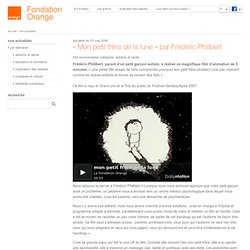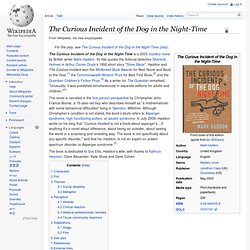

Kaspieman's blog. "Mon petit frère de la lune" par Frédéric Philibert - Fondation. Actualité du 07 mai 2008 Frédéric Philibert, parent d’un petit garçon autiste, a réalisé ce magnifique film d’animation de 5 minutes. « Une petite fille essaie de faire comprendre pourquoi son petit frère (autiste) n’est pas vraiment comme les autres enfants et donne sa version des faits ».

Ce film a reçu le Grand prix et le Prix du public du Festival Handica-Apicil 2007. Nous laissons la parole à Frédéric Philibert « Lorsque nous nous sommes aperçus que notre petit garçon avait un problème, un pédiatre nous a envoyé vers un centre médico psychologique dans lequel nous avons été orientés, nous les parents, vers une démarche de psychanalyse. Nous n’y avons pas adhéré, mais nous avons cherché d’autres solutions ; prise en charge à l’hôpital et programme adapté à domicile, parallèlement nous avons choisi de créer et réaliser un film en famille. Cela a été le moyen de raconter un peu notre histoire, de parler de cet handicap qu’est l’autisme de façon très simple. The Curious Incident of the Dog in the Night-time - Wikipedia, t.
The Curious Incident of the Dog in the Night-Time is a 2003 mystery novel by British writer Mark Haddon.

Its title quotes the fictional detective Sherlock Holmes in Arthur Conan Doyle's 1892 short story "Silver Blaze". Haddon and The Curious Incident won the Whitbread Book Awards for Best Novel and Book of the Year,[1] the Commonwealth Writers' Prize for Best First Book,[2] and the Guardian Children's Fiction Prize.[3] As a writer for The Guardian remarked, "Unusually, it was published simultaneously in separate editions for adults and children. "[4] The novel is narrated in the first-person perspective by Christopher John Francis Boone, a 15-year-old boy who describes himself as "a mathematician with some behavioral difficulties" living in Swindon, Wiltshire. The book is dedicated to Sos Eltis, Haddon's wife, with thanks to Kathryn Heyman, Clare Alexander, Kate Shaw and Dave Cohen. Characters Christopher John Francis Boone Ed Boone Christopher's father, a boiler engineer.
Judy Boone Siobhan. Understanding Asperger Syndrome: A College Professor's Guide. Temple Grandin - Focus on Autism and Asperger's Syndrome. Asperger syndrome. Asperger syndrome (AS), also known as Asperger disorder (AD) or simply Asperger's, is an autism spectrum disorder (ASD) that is characterized by significant difficulties in social interaction and nonverbal communication, alongside restricted and repetitive patterns of behavior and interests.

It differs from other autism spectrum disorders by its relative preservation of linguistic and cognitive development. Although not required for diagnosis, physical clumsiness and atypical (peculiar, odd) use of language are frequently reported.[1][2] The syndrome is named after the Austrian pediatrician Hans Asperger who, in 1944, studied and described children in his practice who lacked nonverbal communication skills, demonstrated limited empathy with their peers, and were physically clumsy.[3] The modern conception of Asperger syndrome came into existence in 1981[4] and went through a period of popularization,[5][6] becoming standardized as a diagnosis in the early 1990s. Classification. What is Asperger Syndrome? Dr Hans Asperger, an Austrian pediatrician, originally described Asperger’s Syndrome in 1944.

The syndrome has more recently been classified as an autistic spectrum disorder. Children and adults with Asperger’s Syndrome have an intellectual capacity within the normal range, but have a distinct profile of abilities that has been apparent since early childhood. The profile of abilities includes the following characteristics: A qualitative impairment in social interaction: Failure to develop friendships that are appropriate to the child’s developmental level. Impaired use of non-verbal behaviour such as eye gaze, facial expression and body language to regulate a social interaction.
From my clinical experience I consider that children and adults with Asperger’s Syndrome have a different, not defective, way of thinking. Copyright © 2005 Tony Attwood. Table of Contents. Syndrome d'Asperger. Un article de Wikipédia, l'encyclopédie libre.

Le syndrome d'Asperger Ce syndrome a été nommé d'après les travaux du pédiatre autrichien Hans Asperger qui décrit en 1943 des enfants chez lesquels on constate un déficit de communication non verbale, une diminution de l'empathie, et une maladresse physique[3]. Ces travaux ne furent révélés qu'en 1981 par Lorna Wing[4], puis traduits en anglais par Uta Frith en 1991[5] et connaissent depuis une médiatisation importante. La cause ou les causes exactes du syndrome d'Asperger sont encore inconnues. Lorsque le diagnostic est établi, une prise en charge pluridisciplinaire avec différentes techniques complémentaires est proposée.